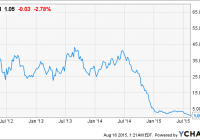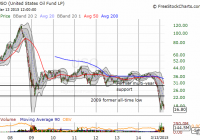AMLP Shareholders Beware
By hidden design, the ALPS Alerian MLP ETF (NYSEARCA: AMLP ) robs shareholders of 37% of their upside gains. It was the first ETF do this, and when I revealed AMLP’s dirty little secret to owners and potential buyers, many did not seem to care. “It’s all about the dividend,” they emphatically stated. “Plus, in a down market, AMLP will only fall 63% of the underlying index,” they crowed. AMLP clips 37% of performance because it is a C-corporation that is liable for federal and state taxes, estimated to be about 37% of any capital appreciation and taxable income. The supposed “benefit” of this horrendous tax drag is that it would act as a buffer during down markets, limiting declines to just 63% of those experienced by the underlying index. However, AMLP is failing to live up to those expectations. The fund has been falling like a rock the past ten weeks. Shareholders missed out on the lion’s share of gains on the upside, and now they are getting screwed again as the fund loses more than its underlying Alerian MLP Infrastructure Index. The promise of smaller losses in a down market is now history. Evidence of this can be found on AMLP’s website , where the one-month performance of the fund was -7.96% for November, while the underlying index is showing a 7.95% loss. The problem began in mid-September, so the three-month performance of -13.36% doesn’t reveal this discrepancy, yet. The performance table also shows that since inception, AMLP has had a cumulative return of +14.63%, while its index returned +34.56%. AMLP has returned less than 38% of the underlying index return. The other 57% has been eaten up by taxes and fees. Owners of AMLP are blinded by the yield. Based on its fourth-quarter distribution of $0.299 and Friday’s (12/4/15) closing price of $10.91, this C-corporation disguised as an ETF has a seductive yield of 10.96%. What many owners do not comprehend is the degree of principal being robbed in order to support the illusion of a high yield. Fortunately, the UBS ETRACS Alerian MLP Infrastructure Index ETN (NYSEARCA: MLPI ) tracks the same Alerian MLP Infrastructure Index, making it easy to see AMLP’s shortcomings. Using data and software from Investors FastTrack , I was able to produce charts making a revealing comparison. Please note that MLPI uses an exchange traded note (“ETN”) structure with its own drawbacks , but its performance helps to understand the flaws of AMLP. Here is a long-term performance graph comparing the two. AMLP is in red, MLPI is in green, and the light-blue line in the lower half shows the relative strength of AMLP to MLPI (a rising line indicates AMLP is performing better than MLPI). From AMLP’s inception on 8/25/2010 through its performance peak on 8/29/2014, it had a total cumulative return of 67.4%. During the same period, MLPI had a total cumulative return of 110.5%. During this rising market, AMLP only returned 61% of what MLPI captured. (click to enlarge) During that up market, MLPI’s price went from $26.74 to $46.22, resulting in 72.8% capital appreciation. Meanwhile, AMLP’s price went from $14.98 to $19.31, resulting in just a 28.9% capital appreciation, or only about 39.7% of what MLPI delivered. One of the unwritten promises of AMLP was that while it lagged on the upside, it would shine in down markets because its deferred tax liabilities would become assets, greatly reducing the downside impact. However, AMLP’s price fell 43.5% from 8/29/2014 through 12/4/2014, while MLPI’s price fell 48.6%. The ratio of AMLP’s price decline to MLPI’s was 89.4%-much worse than the “promised” 63% and nowhere near the 39.7% of the upside it captured. From a total return perspective, AMLP fell 43.5% to MLPI’s 48.6% decline. For the entire cycle, AMLP’s price went from $14.98 to $10.91. This principal erosion of 27.2% is the cost of supporting the 10.96% current yield. Since inception, AMLP has returned 3.8% (0.71% annualized), and MLPI has returned 15.4% (2.75% annualized). AMLP had an upside capture of 61% (39.7% based on price) and a downside capture of 89%. It won’t take too many cycles like this to completely obliterate AMLP’s principal. Zooming in reveals AMLP’s most recent problem. During falling markets, AMLP is supposed to fall much slower than MLPI. That was true from mid-May through mid-September of this year, and it can been seen in the rising light-blue relative-strength line. However, beginning around September 11, that changed. The relative-strength line went flat as AMLP plunged 19.54% between 9/11/2015 and 12/04/2015. Over this same period, MLPI dropped slightly less-19.49%. (click to enlarge) AMLP’s touted downside buffer has disappeared. Presumably because it used up all of its deferred tax liabilities/assets, exposing the more than $6 billion of shareholder assets to the full brunt of the MLP market decline. History has shown that AMLP investors don’t care. They only care about the yield. The erosion of principal helps to exaggerate the current yield while robbing long-term holders of principal. Owners who bought their shares on in 2014 at $19.31 per share do not receive the new 10.96% yield. They are getting a 6.2% yield on their initial investment, and it has cost them 43.5% of their principal. Maybe now they will start to care. Note: In early trading today (12/7/2015), AMLP plunged another 9% to a price of less than $10. Disclosure: Author has no positions in any of the securities, companies, or ETF sponsors mentioned. No income, revenue, or other compensation (either directly or indirectly) is received from, or on behalf of, any of the companies or ETF sponsors mentioned.

